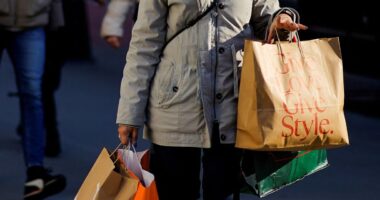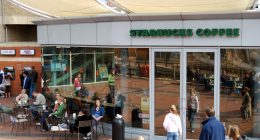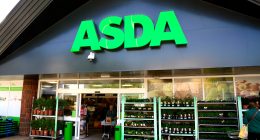The U.S. economy’s 4% fourth-quarter increase wasn’t enough to ward off a full-year contraction from the pandemic’s initial shock, but growth is expected in 2021.
U.S. gross domestic product—the value of all goods and services produced across the economy—rose at a 4.0% seasonally and inflation adjusted annual rate in the final quarter of last year, the Commerce Department said on Thursday, joining a record gain in the third quarter to further reduce losses from earlier in the pandemic.
That left 2020 with a 3.5% annual contraction, measured year over year, and was the first decline since the financial crisis and the largest since 1946. Measured from the fourth quarter to the same quarter a year ago, the economy shrank 2.5%.
The Labor Department separately said the number of workers seeking unemployment benefits dropped last week, indicating a recent easing in the pace of layoffs though the labor market remains mired in a winter slowdown. New jobless claims, a proxy for layoffs, dropped to 847,000 in the week ending Jan. 23, down from a revised 914,000 the week before. Claims have for months remained well above the pre-pandemic peak of 695,000.
The coronavirus and related business disruptions put in place early in the pandemic upended the U.S. economy early last year, triggering business and school closures, a steep drop in demand for goods and services and record job losses. The economy rebounded in the second half of the year as it reopened, with sharp gains in employment and consumer spending over the summer that were helped by trillions of dollars in government aid.
While the recovery has slowed this winter, economists expect it will pick up again later in 2021, once the pandemic is under control, though the coronavirus remains a threat to the global economy.
“Coming out of the disaster of the pandemic, we’re going to see outsized growth from the second quarter onwards and a sharp decline in joblessness,” said Joseph Brusuelas, chief economist at RSM US LLP.
The International Monetary Fund expects the U.S. economy to grow 5.1% this year, while economists surveyed by the Journal projected 4.3% growth, measured from the fourth quarter of the prior year.
Economists expect hiring to start slowly this year, after employers shed jobs in December. But they also expect momentum to grow later, as the Covid-19 vaccine becomes widely available, hospital burdens ease and consumers resume activities such as dining out, sporting events and vacations. Offices could reopen to more workers, which would lead to lunches out and drinks after work.
Other factors in play include government aid and accumulated savings from those who continued to work but reduced spending during the pandemic.
Consumer spending is the engine of U.S. economic output, and a pickup in spending would in turn lead to more hiring, particularly in some of the hardest-hit sectors such as restaurants, hotels, stores and personal services.
SHARE YOUR THOUGHTS
What do you think the economic recovery will look like? Join the conversation below.
“We expect there to be plenty of growth over the late spring and summer as the service sector of the economy ramps back up,” said Daniil Manaenkov, an economic forecaster at the University of Michigan.
Several states, including California and New York, have recently rolled back restrictions, and many Southern states essentially have no restrictions, Mr. Manaenkov said. That allows for activity to grow quickly once consumers feel good about heading out, he said.
Employers are poised to add more than five million jobs this year, according to economists surveyed by the Journal. That would make 2021 the best year for employment gains in records dating to 1939, topping 4.3 million jobs created in 1946 at the start of the post-World War II expansion.
Still, even record-setting hiring this year would leave the U.S. millions of jobs short of pre-pandemic employment heading into 2022.
The impact of the pandemic has been unevenly felt across the country, with some regions such as the South holding up better than others.
And some industries have thrived, such as technology firms, logistics companies and online retailers, while others such as in-person services businesses struggled.
The GDP report is expected to show that consumer spending and business investment likely eased in the fourth quarter after recording outsize strength in the third quarter. Trade is expected to be a drag on growth as the U.S. imported more than it exported.
The housing market is expected to continue to perform strongly, as families working from home have bought bigger residences or spent money on improving their properties. That has also given a boost to spending on durable goods—long-lasting items like new washing machines and furniture.
Per-share earnings for S&P 500 companies fell 4.3% in the fourth quarter, compared with fourth-quarter 2019, according to data from Refinitiv, reflecting results for 114 companies and analysts’ expectations for the remainder of the index. Sales fell 0.4% year over year, but rose 2.7% excluding the volatile energy sector.

Hank Saipe owns five self-storage facilities in Denver.
Photo: Cheryl Saipe
Still, those declines are significant improvements from earlier periods during the year. Per-share earnings fell 6.5% year over year in the third quarter, and 30.6% in the second quarter, Refinitiv said. Energy, industrial and consumer-discretionary companies saw the biggest earnings declines in the fourth quarter, while financial, tech and materials companies saw year-over-year gains of 9% or higher.
Michael Stephans, co-owner of the Velvet Shoestring, a high-end furniture resale and décor shop in Williamsburg, Va., said business has been good and that sales held steady during the holidays, months that are typically slower because “a sectional sofa is not a Christmas item.”
“I think a lot more people have conserved money on vacations and things like that. So they’re spending them in the house,” he said.
For Hank Saipe, who owns five self-storage facilities in Denver, the impact of Covid-19 has also been relatively minor. Occupancy rates are up from last year as more people are moving house and setting up home offices during the pandemic, which means he has been able to raise rental rates, too.
Regarding the pandemic more broadly, the 65-year old said he is “trying to be as strict as possible,” wearing masks and limiting travel until he gets a vaccine. It has been a year since he last visited a theater or went to the movies, and he does curbside pickup from restaurants rather than dining inside. “I’m looking forward to my daughter’s wedding in August. Hopefully, we can have it,” Mr. Saipe said.
— Hannah Lang and Theo Francis contributed to this article.
Write to Harriet Torry at [email protected] and Eric Morath at [email protected]
Copyright ©2020 Dow Jones & Company, Inc. All Rights Reserved. 87990cbe856818d5eddac44c7b1cdeb8









